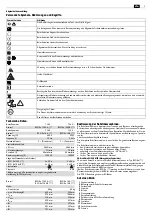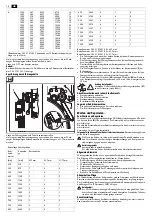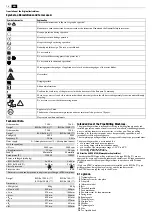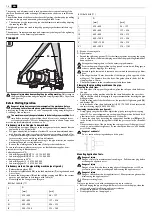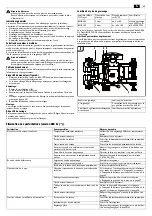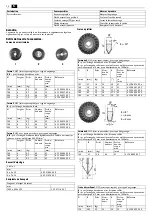
15
en
17
Pipe nut
18
Fastening screw for motor
19
Bracket
20
Drive sprocket
21
Transport shaft
22
Securing ring
23
Pin
24
Screw plug of tool spindle head
25
Carrying handle (insulated gripping surfaces)
26
Depth scale
27
Knurled nut
28
Feed switching lever
29
Chain-tensioner hexagon
30
Chain-tensioner disc
31
Securing screws of chain tensioner
32
Securing ring for chain link
33
Bolt of chain link
34
Carrying straps
For your safety.
General safety rules.
Read all safety warnings, instructions, figures and technical
data provided with power tool.
Failure to follow the warnings
and instructions may result in electric shock, fire and/or serious injury.
Save all safety warnings and instructions for future reference.
The term “power tool” used in the safety instructions, refers to mains-powered
power tools (with mains cable) and to battery-operated power tools (without
mains cable).
1) Work area safety
a) Keep work area clean and well lit.
Cluttered or dark areas invite accidents.
b) Do not operate power tools in explosive atmospheres, such as in the pres-
ence of flammable liquids, gases or dust.
Power tools create sparks which
may ignite the dust or fumes.
c) Keep children and bystanders away while operating a power tool.
Distrac-
tions can cause you to lose control.
2) Electrical safety
a) Power tool plugs must match the outlet. Never modify the plug in any way.
Do not use any adapter plugs with earthed (grounded) power tools.
Unmodified plugs and matching outlets will reduce risk of electric shock.
b) Avoid body contact with earthed or grounded surfaces, such as pipes, radi-
ators, ranges and refrigerators.
There is an increased risk of electric shock
if your body is earthed or grounded.
c) Do not expose power tools to rain or wet conditions.
Water entering a power
tool will increase the risk of electric shock.
d) Do not abuse the cord. Never use the cord for carrying, pulling or unplugging
the power tool. Keep cord away from heat, oil, sharp edges or moving parts.
Damaged or entangled cords increase the risk of electric shock.
e) When operating a power tool outdoors, use an extension cord suitable for
outdoor use.
Use of a cord suitable for outdoor use reduces the risk of elec-
tric shock.
f) If operating a power tool in a damp location is unavoidable, use a residual
current device (RCD) protected supply.
Use of an RCD reduces the risk of
electric shock.
3) Personal safety
a) Stay alert, watch what you are doing and use common sense when operat-
ing a power tool. Do not use a power tool while you are tired or under the
influence of drugs, alcohol or medication.
A moment of inattention while
operating power tools may result in serious personal injury.
b) Use personal protective equipment. Always wear eye protection.
Protective
equipment such as a dust mask, non-skid safety shoes, hard hat or hearing
protection used for appropriate conditions will reduce personal injuries.
c) Prevent unintentional starting. Ensure the switch is in the off-position
before connecting to power source and/or battery pack, picking up or car-
rying the tool.
Carrying power tools with your finger on the switch or ener-
gising power tools that have the switch on invites accidents.
d) Remove any adjusting key or wrench before turning the power tool on.
A
wrench or a key left attached to a rotating part of the power tool may result
in personal injury.
e) Do not overreach. Keep proper footing and balance at all times.
This enables
better control of the power tool in unexpected situations.
f) Dress properly. Do not wear loose clothing or jewellery. Keep your hair and
clothing away from moving parts.
Loose clothes, jewellery or long hair can
be caught in moving parts.
g) If devices are provided for the connection of dust extraction and collection
facilities, ensure these are connected and properly used.
Use of dust collec-
tion can reduce dust-related hazards.
h) Do not let familiarity gained from frequent use of tools allow you to become
complacent and ignore tool safety principles.
A careless action can cause
severe injury within a fraction of a second.
4) Power tool use and care
a) Do not force the power tool. Use the correct power tool for your application.
The correct power tool will do the job better and safer at the rate for which
it was designed.
b) Do not use the power tool if the switch does not turn it on and off.
Any
power tool that cannot be controlled with the switch is dangerous and must
be repaired.
c) Disconnect the plug from the power source and/or remove the battery pack,
if detachable, from the power tool before making any adjustments, chang-
ing accessories, or storing power tools.
Such preventive safety measures
reduce the risk of starting the power tool accidentally.
d) Store idle power tools out of the reach of children and do not allow persons
unfamiliar with the power tool or these instructions to operate the power
tool.
Power tools are dangerous in the hands of untrained users.
e) Maintain power tools and accessories. Check for misalignment or binding of
moving parts, breakage of parts and any other condition that may affect the
power tool’s operation. If damaged, have the power tool repaired before
use.
Many accidents are caused by poorly maintained power tools.
f) Keep cutting tools sharp and clean.
Properly maintained cutting tools with
sharp cutting edges are less likely to bind and are easier to control.
g) Use the power tool, accessories and tool bits etc. in accordance with these
instructions, taking into account the working conditions and the work to be
performed.
Use of the power tool for operations different from those
intended could result in a hazardous situation.
h) Keep handles and grasping surfaces dry, clean and free from oil and grease.
Slippery handles and grasping surfaces do not allow for safe handling and
control of the tool in unexpected situations.
5) Service
a) Have your power tool serviced by a qualified repair person using only iden-
tical replacement parts.
This will ensure that the safety of the power tool is
maintained.
Specific safety rules for pipe milling machines.
Observe the national regulations for prevention of accidents when starting-
up, working on and maintaining the pipe milling machine.
Observe the statutory explosion-protection guidelines.
Ensure that the pipe being cut is firmly supported. Non-observance of this
safety instruction can lead to serious injury or death.
Electrically-operated pipe milling machines (design RSG Ex (**)).
The mains voltage and the voltage specification on the pipe milling machine must
correspond.
The supply connection of the pipe milling machine must be protected with a 20 A
fuse.
Check the power cord and, if necessary, the extension cable regularly!
Connect the pipe milling machine to the switchgear assembly only when the main
switch is switched off.
The switchgear assembly must be accessible by the operator at all times.
Application.
Keep handles and gripping surfaces dry, clean, and free from oil and grease.
Slip-
pery handles and gripping surfaces do not allow safe operation and control of the
machine in unexpected situations.
Hold power tool by insulated gripping surfaces only, because the cutting tool could
cut into the machine's power cord.
Contact with a “live” wire make exposed metal
parts of tool “live” and shock the operator.
Do not overload the pipe milling machine. Use the right application tool for your
work.
Your work performance will be better and more safe when using the right
application tool.
Do not use a pipe milling machine with a defective switch.
A pipe milling machine
that can no longer be switched on or off is dangerous and must be repaired.
Disconnect the power supply before making machine settings or changing applica-
tion tools.
This safety measure prevents accidental starting of the pipe milling
machine.
Do not allow persons unfamiliar with the pipe milling machine or these instructions
to operate the machine.
Pipe milling machines are dangerous in the hands of
untrained users.
Maintain the pipe milling machine at regular intervals. Inspect the pipe milling
machine for possible damage as well as for other factors that may interfere with
the operation of the pipe milling machine. Repair a pipe milling machine not in
proper order before usage.
Many preventable accidents are caused by poorly main-
tained pipe milling machines.
Use the pipe milling machine, the accessories as well as application tools accord-
ing to the instructions in this manual, whereby the working conditions and the
activities to be carried out are to be taken into consideration.
The use of pipe mill-
ing machines for applications different from those intended could result in hazard-
ous situations.
Operation (see figure A).
The pipe milling machine cuts and mills exposed pipe sections and laid pipes with
the use of cutting application tools. It is clamped to the outside of the pipe by its
tightening device and moves around the pipe with automatic working feed. The
cutting tools used are metal circular saw blades and profile cutters with cutting
edges are made of HSS steel or carbide, depending on the pipe material.
–
The cutting depth is adjusted by the tool spindle head (
16
), which is seated in
both side plates (
3
); it can be pivoted, and is adjusted by means of the threaded
spindle (
6
).
–
The transport shaft (
21
), which creates the operational feed motion via the
transport wheels, is driven by the tool spindle via 2 worm gear stages.
–
The feed motion can be switched on or off via the feed switching lever (
28
). A
safety clutch protects the feed gearing against overload.
The bearing of the tool spindle is particularly rigid. The oil-bath lubricated main
gearbox for driving the tool spindle consists of a planetary and worm gear stage.
WARNING
Содержание RSG Ex 1500 A Series
Страница 1: ...RSG Ex 1500 A 7 360 RSG Ex 1500 B 7 360 RSG Ex 18 A 7 360 RSG Ex 18 B 7 360...
Страница 282: ...282 th 4 a b c d e f g h 5 a RSG Ex 20 A HSS 16 3 6 21 2 28 10 34 B 34...
Страница 290: ...290 th www fein com CE EFTA European Free Trade Association EU EFTA FEIN C E Fein GmbH D 73529 Schw bisch Gm nd...
Страница 298: ...298 ja RSG Ex 3 2 3 3 I 3 2 3 FEIN 3 07 02 041 01 4 A 293 294 295 294 296 FEIN 11...





